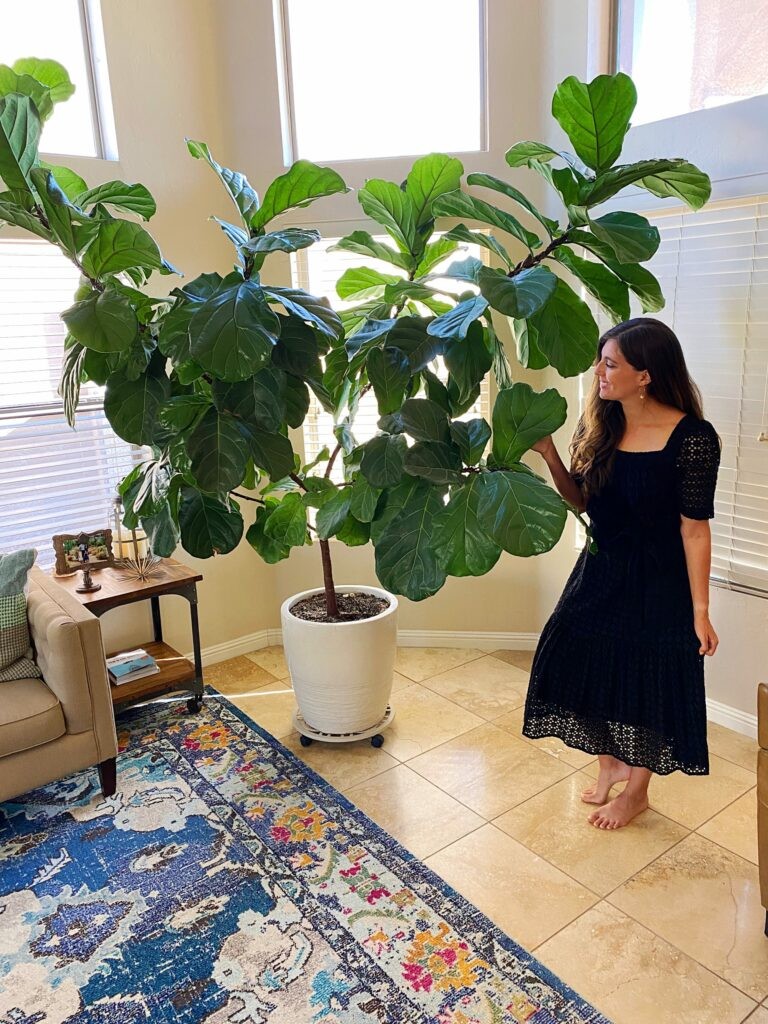Meet Frida Kahlo, our stunning fiddle leaf fig (FLF) tree, the leafy green greeter of our home. Frida is no stranger to compliments, both in person and online, and I’m constantly asked about the secrets to her vibrant health. For a long time, I hesitated to share my tips, haunted by my past as a self-proclaimed plant killer. However, over the last few years, I’ve finally found my rhythm and developed a care routine that works. While I’m still slightly superstitious about jinxing my plant success, I’m taking the plunge to share what I’ve learned.
My hope is that these tried-and-true methods will help you cultivate your own flourishing fiddle leaf fig. And for all my fellow FLF enthusiasts, please enrich this guide by sharing your personal tips in the comments below!
Understanding the Fiddle Leaf Fig Tree
The fiddle leaf fig, scientifically known as Ficus lyrata, is a tropical tree celebrated for its large, uniquely shaped leaves resembling fiddles or lyres. Native to Western Africa, these trees thrive outdoors in warm, humid climates.
Over the past decade, fiddle leaf figs have become incredibly popular as indoor plants. They’ve graced countless magazine covers, Instagram feeds, and Pinterest boards, becoming synonymous with modern, stylish interiors. A fiddle leaf fig is more than just a plant; it’s a statement piece that brings architectural elegance and natural beauty into your living space. However, they also have a reputation for being finicky and challenging to maintain, adding to their mystique and the satisfaction of successfully nurturing one.
In this guide, I’ll walk you through the essential aspects of how to take care of a fiddle leaf fig tree, from finding the perfect spot to repotting and everything in between, ensuring your FLF remains lush, healthy, and a vibrant part of your home for years to come.
 A healthy fiddle leaf fig tree in a pot, showcasing its lush green leaves and robust trunk, placed in a brightly lit room.
A healthy fiddle leaf fig tree in a pot, showcasing its lush green leaves and robust trunk, placed in a brightly lit room.
Mastering Fiddle Leaf Fig Care: Essential Tips
Optimal Placement and Light Exposure
Finding the right location is paramount for fiddle leaf fig care. Originating from tropical environments, these plants crave sunlight. Ideally, position your fiddle leaf fig near a north or south-facing window where it can bask in bright, indirect sunlight for several hours daily. Homes with high ceilings, skylights, and expansive windows often provide the perfect bright environment for these light-loving plants. If your home receives limited natural light, consider supplementing with a grow light to ensure your FLF gets adequate illumination. Many members of online fiddle leaf fig communities successfully use grow lights to boost their plant’s health.
Also, be mindful of environmental factors within your home. Avoid placing your fig tree directly in the path of air conditioning or heating vents, as the direct airflow can dehydrate the leaves and cause stress.
While fiddle leaf figs adore light, be cautious of intense, direct sunlight, especially during the hottest parts of the day. Direct sunbeams can scorch the delicate leaves, leading to sunburn, characterized by dry, brown patches. We learned this lesson with our other fig, Fred, who experienced sunburn after being left outside. Bright, indirect light is the sweet spot, mimicking their natural habitat under the canopy of taller trees. Light conditions truly are a game-changer in fiddle leaf fig care.
Effective Watering Techniques
Watering is often cited as the trickiest aspect of fiddle leaf fig care, and there are varying approaches. Some advocate for frequent, small amounts of water (the “cup method”), while others prefer less frequent, but thorough watering. I found the “cup method” to be ineffective for my Frida. She began dropping leaves, and I was perplexed until I discovered the magic of a water meter. This affordable tool from Amazon has been a revelation. I check the soil moisture level every 7-10 days, and I only water when the meter reads a 2 or 3, indicating dry soil. When watering, I saturate the soil completely. I use approximately four large measuring bowls of filtered water, ensuring the entire root ball is thoroughly drenched.
Frida seems to have a preference for filtered water, particularly from the refrigerator, over tap water. Our Tucson tap water can be quite acidic, and I noticed it negatively impacting her leaves. Consider the water quality in your area and whether filtered water might benefit your plant.
Before watering, I recommend using a water meter or even a chopstick to gently poke holes in the soil surface. This simple step improves soil aeration, allowing oxygen to reach the roots and water to penetrate the soil more evenly. A good rule of thumb for watering amount is to continue watering until you see water draining from the pot’s drainage holes. Once drainage begins, stop watering and allow the excess water to drain away completely.
One final tip: fiddle leaf figs absolutely love rainwater! Rainwater seems to have a beneficial effect on plants compared to tap water. If it rains, consider moving your sturdy potted FLFs outdoors to enjoy a natural shower. You might be surprised by the positive response.
Choosing the Right Potting Medium and Pot
Before repotting your newly acquired fiddle leaf fig, allow it to acclimate to its new environment. Keep it in its nursery pot and place it in the area of your home where it will permanently reside. This adjustment period minimizes transplant shock when you eventually repot.
Selecting the correct potting mix is crucial for fiddle leaf fig health. The ideal potting medium should be well-draining, preventing water retention which can lead to root rot. Avoid heavy soils that stay consistently damp. While specialized fiddle leaf fig potting mixes are available, many growers have found success with cactus and succulent soil blends, known for their excellent drainage properties. I’ve personally used Miracle Grow potting soil with good results. Consult your local nursery for potting mix recommendations tailored to your specific climate and plant needs.
When it comes to pot size, resist the urge to immediately place your fig in an oversized container. Fiddle leaf figs actually prefer to be slightly root-bound and often thrive in pots that are only slightly larger than their nursery containers. Choose a pot that is approximately the same size or just a bit larger than the original pot. Drainage is paramount. Ensure your chosen pot has at least one drainage hole at the bottom to allow excess water to escape. I also like to add a layer of small rocks or pebbles at the base of the pot before adding soil. This creates an additional drainage layer, further safeguarding against root rot by promoting efficient water flow.
Fertilizing for Enhanced Growth (If Needed)
Fertilizing is not always necessary, especially if your fiddle leaf fig is planted in nutrient-rich soil and is exhibiting healthy growth. However, if you notice signs of slow growth or pale leaves, a gentle fertilizer boost can be beneficial. I recommend using this particular fertilizer diluted with filtered water. As with watering, I found that using tap water with fertilizer caused acidity issues, so I switched to filtered water for fertilizing as well.
If you choose to fertilize, do so sparingly, typically only twice a year: once during the active growing season in summer and again during winter. Over-fertilizing can be more harmful than under-fertilizing, so err on the side of caution.
Routine Maintenance Practices
Misting is a beneficial routine care practice, especially since fiddle leaf figs thrive in humid environments. If you live in a dry climate, regular misting can significantly improve leaf health and prevent them from drying out. You can use a humidifier placed near your plant on a low setting or manually mist the leaves periodically. I use this fine-mist sprayer from Amazon and mist the leaves whenever I water, approximately every 7-12 days.
In addition to misting, regularly cleaning the leaves is important. Dust accumulation on the broad leaves can hinder their ability to absorb sunlight. After misting, I gently wipe each leaf with a paper towel to remove any dust. Clean leaves are more efficient at photosynthesis and contribute to overall plant vigor.
Some enthusiasts recommend gently shaking the trunk of young or weaker fiddle leaf figs every few days. This practice is believed to simulate natural wind exposure, encouraging the trunk to strengthen over time. While I haven’t personally implemented trunk shaking for Frida, I might try it with Fred to see if it promotes sturdier growth.
A fun fact to keep in mind: fiddle leaf figs are capable of growing quite tall indoors, potentially reaching the ceiling. With our 30-foot ceilings, I’m secretly hoping Frida reaches impressive heights!
Repotting Considerations
Fiddle leaf figs generally prefer minimal disturbance, so repotting should only be undertaken when absolutely necessary. Repotting can cause stress to these sensitive plants, so avoid it unless there are clear indicators that it’s needed. While some guides suggest repotting every 2-3 years to replenish soil nutrients, I believe that if your plant is thriving, it’s best to leave it undisturbed.
Signs that indicate your fiddle leaf fig might need repotting include: soil pulling away from the pot edges with visible root exposure, signs of bacterial infection (numerous brown spots on leaves), or root rot (indicated by mushy roots). Preventative measures like ensuring adequate drainage and avoiding overwatering are crucial in minimizing the risk of root rot.
If repotting becomes necessary, gently remove the plant from its pot and shake off any loose soil from the root ball. Trim away any excessively long or circling root ends, essentially giving the roots a “haircut.” If you identify any mushy, decaying roots (a sign of root rot), prune these away as well. Place a layer of fresh potting mix at the bottom of the new pot, position the plant, and fill the remaining space with fresh potting soil. Water thoroughly after repotting.
And that concludes my comprehensive guide on fiddle leaf fig care! I’ll continue to update this post with any new tips or insights I gain along my plant parenting journey.
Do you have your own plant babies? What valuable lessons have you learned in your plant care experiences? Please share your fiddle leaf fig care tips and any other plant wisdom in the comments below!
xo
Gina
Success! Check your email for a free 30-day meal and fitness cheat sheet
You might also like:
Posted in today’s tip
Post Navigation:
146: Metabolic health and biohacking with Joshua Kreifels, RD → ← Friday Faves 12.8

